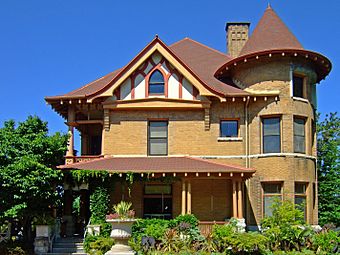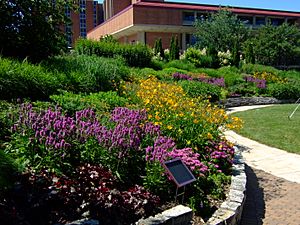Allen Centennial Gardens facts for kids
Quick facts for kids |
|
|
Agricultural Dean's House
|
|
 |
|
| Location | 10 Babcock Dr., Madison, Wisconsin |
|---|---|
| Area | 1.9 acres (0.77 ha) |
| Built | 1896 |
| Architect | Conover & Porter |
| Architectural style | Queen Anne |
| NRHP reference No. | 84003627 |
| Added to NRHP | September 20, 1984 |
The Allen Centennial Garden is a beautiful public garden you can visit for free. It's located on the campus of the University of Wisconsin–Madison in Madison, Wisconsin. This special place includes the Agricultural Dean's House, which was once home to the first four leaders (called deans) of the College of Agricultural and Life Sciences.
The Dean's House
The house you see overlooking the garden is built in the Queen Anne style. It was designed for William Arnon Henry, who was the very first dean of the University of Wisconsin–Madison College of Agriculture. When he first came to the university, he bought a small farmhouse on campus.
In the 1890s, other universities tried to hire Dean Henry away from Wisconsin. To keep him, the university offered him more money and vacation time. They also gave him $8,000 to build a new house. Later, another $2,000 was added to the project. The house was finished in 1896. After it was built, Dean Henry paid for any further costs himself. The house was designed by architects Allan D. Conover and Lew F. Porter.
Dean Henry led the college from 1887 until 1907, when he retired due to poor health. After him, three other deans lived in the house:
- Harry Luman Russell (from 1907 to 1931)
- C. L. Christensen (from 1931 to 1943)
- Edwin Broun Fred (from 1943 to 1945)
Even after Dean Fred became the president of the university, his family continued to live in the house. In 1980, they moved out, and the house became offices for the university's Experimental Farms.
On September 20, 1984, the house received a special honor. It was added to the National Register of Historic Places by the National Park Service. This means it's recognized as an important historical building. The Experimental Farms offices moved out in 2011. The inside of the house is now being prepared for future renovations.
Exploring the Gardens
In 1979, the teaching gardens near the Plant Sciences Building were removed to make space for a new addition. In the early 1980s, the university decided to create new gardens at the old dean's house. Money for the first plans and designs came from university gifts and student groups.
A generous gift from Ethel Allen, whose husband Oscar Allen was a famous scientist, helped start the garden construction. Work began in the spring of 1985. The garden was finished in October 1989. It was named the Allen Centennial Gardens to honor Oscar Allen and to celebrate the 100th anniversary of the College of Agricultural and Life Sciences. The gardens continue to be supported by donations.




